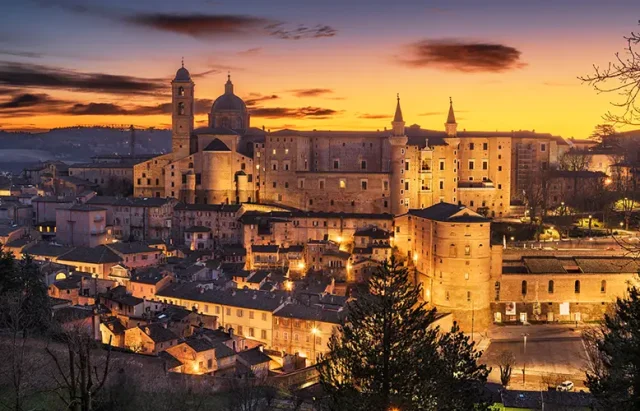
The road to Urbino winds through the soft hills of northern Marche, curving past olive groves and stone farmhouses. The town rises suddenly from the landscape, its towers and domes catching the light as if lifted from a painting. From a distance, Urbino seems almost unreal — a vision of balance, geometry, and grace.
This was the birthplace of Raphael, and it still feels like a place where proportion matters. The city sits high on a ridge, protected by walls, its streets following the rhythm of the hill itself. Every turn reveals a view — tiled roofs falling into shadow, green valleys fading into haze. Urbino is small enough to walk in an hour, but you could spend days tracing its lines and still not see everything.
The City of the Ideal
Urbino’s golden age came in the fifteenth century under Duke Federico da Montefeltro, one of the great patrons of the Italian Renaissance. His court attracted architects, painters, philosophers, and mathematicians who believed that beauty was a form of order. They built a city that embodied that belief.
The Palazzo Ducale, with its twin towers and wide terraces, is the heart of Urbino. Inside, light falls softly on polished stone floors, illuminating arches and frescoes that still seem to hum with thought. Federico’s study, a small wooden chamber lined with intricate inlay, feels intimate and vast at the same time. Its marquetry panels depict musical instruments, books, and globes — symbols of a world shaped by curiosity rather than power.
From the palace balcony, you can see the hills spreading out in every direction. It is easy to understand how this landscape shaped an idea of perfection. Everything feels deliberate but not forced. The city and the countryside mirror each other — one built in brick and marble, the other in soil and sky.
The Rhythm of the Streets
Urbino is steep, and its streets move in spirals rather than straight lines. Walking through them is like following the thought process of the Renaissance itself: precise, winding, and full of surprises. Small archways open onto courtyards, stairways climb past shuttered windows, and the scent of coffee drifts from doorways where students gather before class.
This is still a university town, one of Italy’s oldest. The presence of young people keeps Urbino from becoming a museum. Books, conversation, and the quiet hum of daily life flow through its piazzas. Cafés spill onto cobbled corners, and the rhythm of footsteps becomes part of the city’s music.
At midday, the light sharpens, cutting between the towers and domes. In the afternoon, it softens again, turning the brick walls a deep terracotta. Everything slows, as if the town remembers how time once moved when art was made by hand.
The Hills Beyond the Walls
Leave the city through Porta Lavagine and the landscape opens at once. The air smells of wheat and wild herbs, and the road descends into the folds of the Marche hills. Here, the countryside is gentle, almost architectural in its design. Every slope holds a field, every ridge a row of cypresses or vines.
This region is made for movement. Many bike tours in Italy pass through Urbino, connecting the Renaissance hill towns with smaller villages like Fermignano and Urbania. Cyclists follow quiet roads that curve through farmland and oak woods, stopping in local trattorias for simple meals and glasses of Verdicchio. The pace matches the place — steady, deliberate, unhurried.
From the saddle, you see the city differently. The towers appear and disappear with each bend, rising from the hills like an idea returning to memory. The ride is neither demanding nor easy; it feels balanced, as everything in Urbino seems to be.
Raphael and the Memory of Form
Urbino gave the world Raphael, and in many ways, he never left it. His birthplace, a modest house on Via Raffaello, still stands with its original beams and a quiet sense of light. A small copy of his Madonna and Child hangs on the wall, and outside the window, the view stretches over the same rooftops he once saw.
What is striking about Raphael’s art is not grandeur but harmony. His paintings hold a stillness that feels unmistakably Urbino-like — calm, symmetrical, and deeply human. To look at them is to glimpse the city’s soul, captured in color and line.
This is what Urbino gives to those who visit: not spectacle, but a lesson in proportion. It shows how beauty and thought can coexist without noise.
Evening on the Ridges
When the sun begins to set, the town glows from within. The walls turn gold, the rooftops red, and the air takes on the faint scent of wood smoke and warm stone. The Piazza della Repubblica fills with quiet voices and the sound of footsteps echoing off the arches.
From the viewpoint above the city, you can watch the day end slowly. The landscape fades into blue layers, and the lights in the palace windows begin to flicker. There is no single moment when day becomes night — only a gradual dimming, as though the world itself were exhaling.
Urbino feels different at dusk. It becomes private again, folded back into its hills. The beauty is not in what you see but in how the place makes you slow down and notice.
A City That Endures
Urbino has survived earthquakes, wars, and centuries of change without losing its balance. The university keeps it young, the hills keep it grounded, and the idea of harmony still runs through its stones. Nothing about it feels accidental.
Travelers often speak of Florence or Siena when they talk about Renaissance Italy, but Urbino holds something more personal — a quieter expression of the same ideals. It was never built to impress. It was built to last.
To walk its streets or ride its hills is to step into a place where art and life remain inseparable. The lines of a fresco, the curve of a wall, the turn of a path — everything seems connected. Urbino does not change you by force. It simply reminds you of what proportion feels like.





